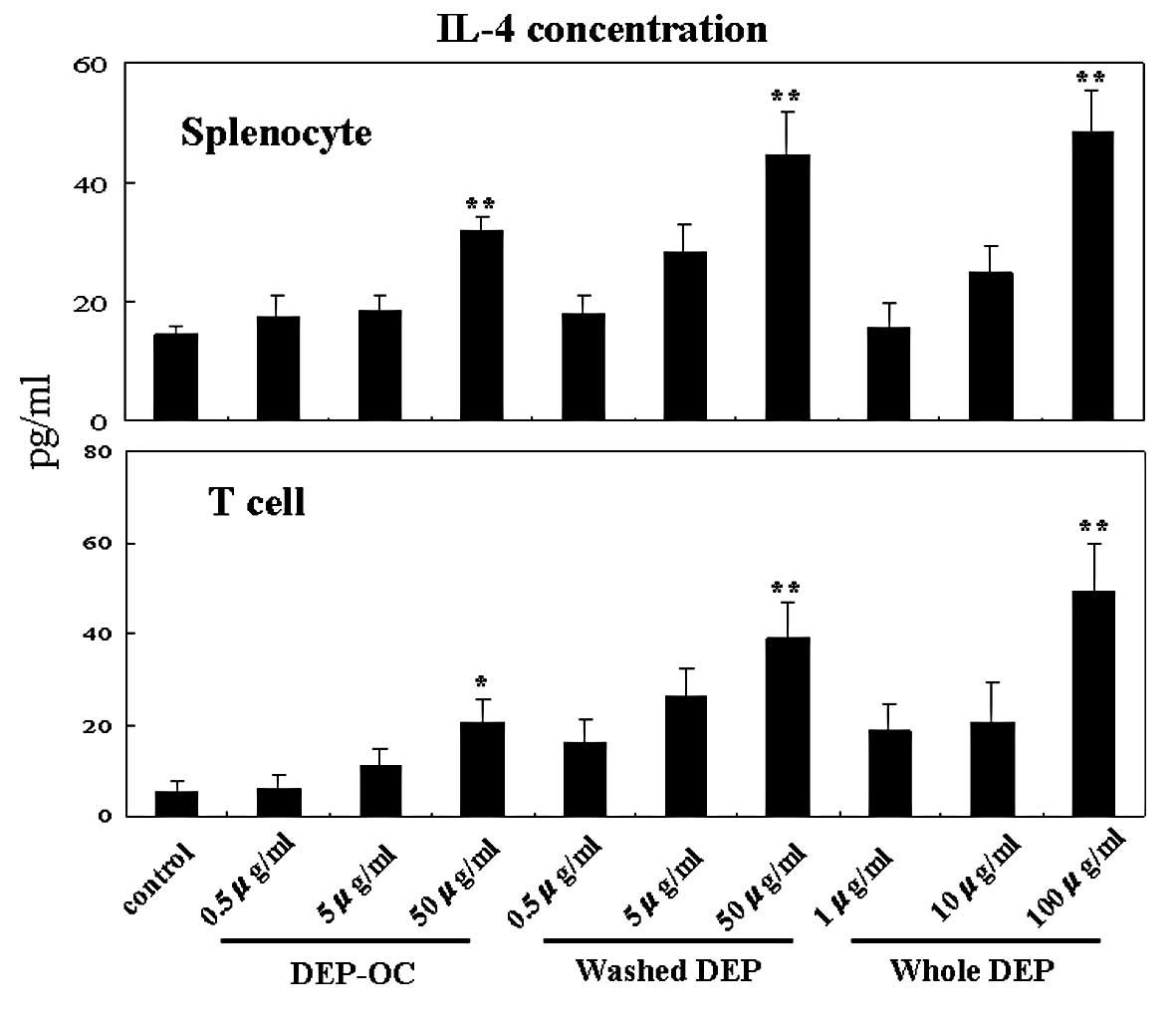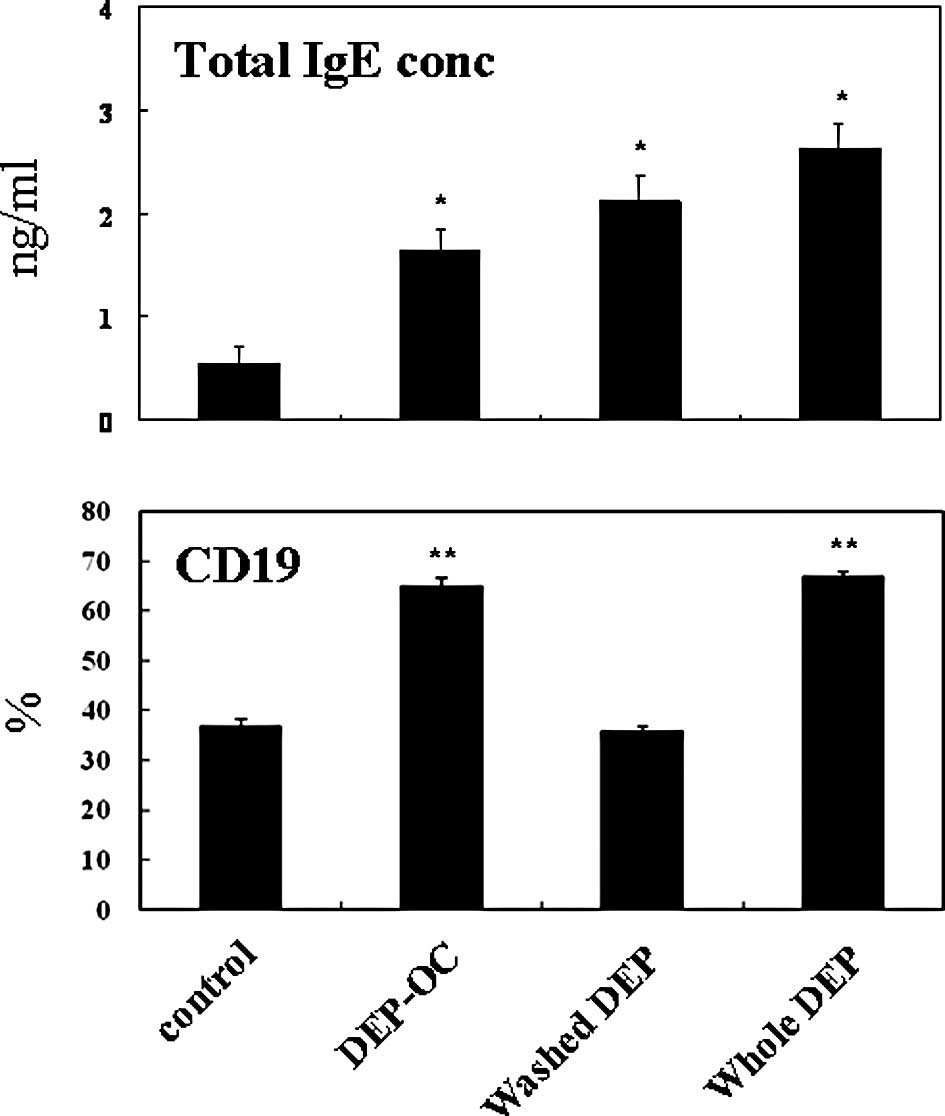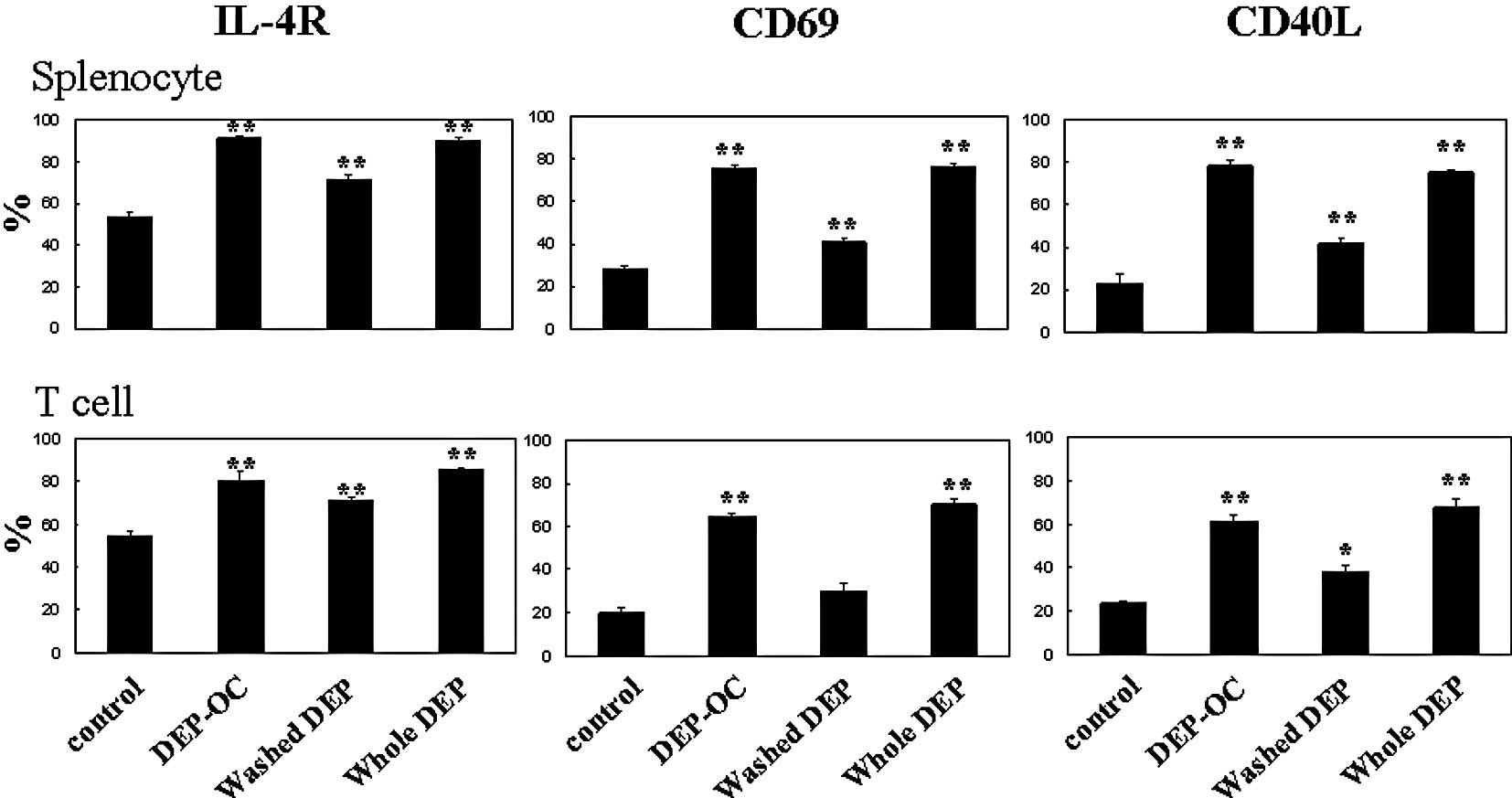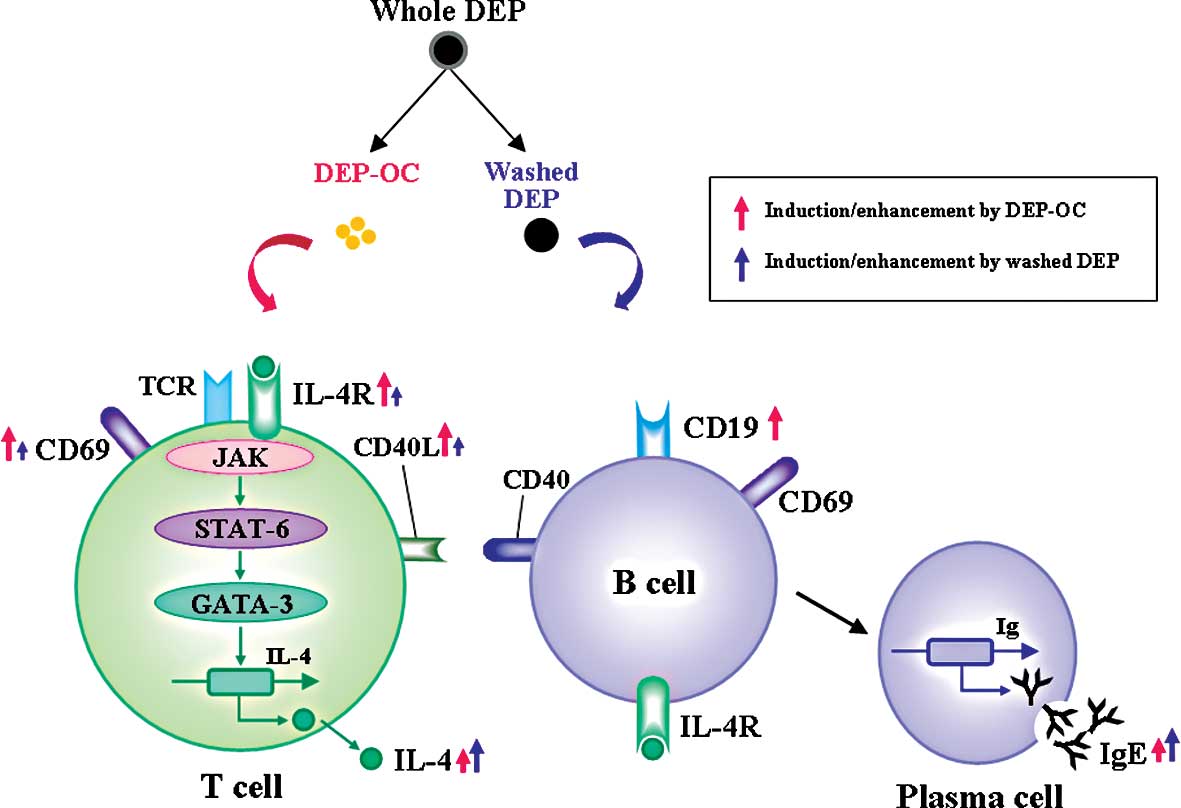|
1.
|
Ichinose T, Furuyama A and Sagai M:
Biological effects of diesel exhaust particles (DEP). II. Acute
toxicity of DEP introduced into lung by intratracheal instillation.
Toxicology. 99:153–167. 1995. View Article : Google Scholar : PubMed/NCBI
|
|
2.
|
Takano H, Yoshikawa T, Ichinose T,
Miyabara Y, Imaoka K and Sagai M: Diesel exhaust particles enhance
antigen-induced airway inflammation and local cytokine expression
in mice. Am J Respir Crit Care Med. 156:36–42. 1997. View Article : Google Scholar : PubMed/NCBI
|
|
3.
|
Ichinose T, Takano H, Miyabara Y and Sagai
M: Long-term exposure to diesel exhaust enhances antigen-induced
eosinophilic inflammation and epithelial damage in the murine
airway. Toxicol Sci. 44:70–79. 1998. View Article : Google Scholar
|
|
4.
|
Miyabara Y, Takano H, Ichinose T, Lim HB
and Sagai M: Diesel exhaust enhances allergic airway inflammation
and hyperresponsiveness in mice. Am J Respir Crit Care Med.
157:1138–1144. 1998. View Article : Google Scholar : PubMed/NCBI
|
|
5.
|
Takano H, Ichinose T, Miyabara Y,
Yoshikawa T and Sagai M: Diesel exhaust particles enhance airway
responsiveness following allergen exposure in mice. Immunopharmacol
Immunotoxicol. 20:329–336. 1998. View Article : Google Scholar : PubMed/NCBI
|
|
6.
|
Terada N, Maesako K, Hiruma K, Hamano N,
Houki G, Konno A, Ikeda T and Sai M: Diesel exhaust particulates
enhance eosinophil adhesion to nasal epithelial cells and cause
degranulation. Int Arch Allergy Immunol. 114:167–174. 1997.
View Article : Google Scholar
|
|
7.
|
Takizawa H, Abe S, Okazaki H, Kohyama T,
Sugawara I, Saito Y, Ohtoshi T, Kawasaki S, Desaki M, Nakahara K,
Yamamoto K, Matsushima K, Tanaka M, Sagai M and Kudoh S: Diesel
exhaust particles upregulate eotaxin gene expression in human
bronchial epithelial cells via nuclear factor-kappa B-dependent
pathway. Am J Physiol Lung Cell Mol Physiol. 284:L1055–L1062. 2003.
View Article : Google Scholar
|
|
8.
|
Terada N, Hamano N, Maesako KI, Hiruma K,
Hohki G, Suzuki K, Ishikawa K and Konno A: Diesel exhaust
particulates upregulate histamine receptor mRNA and increase
histamine-induced IL-8 and GM-CSF production in nasal epithelial
cells and endothelial cells. Clin Exp Allergy. 29:52–59. 1999.
View Article : Google Scholar
|
|
9.
|
Beck-Speier I, Dayal N, Karg E, Maier KL,
Schumann G, Schulz H, Semmler M, Takenaka S, Stettmaier K, Bors W,
Ghio A, Samet JM and Heyder J: Oxidative stress and lipid mediators
induced in alveolar macrophages by ultrafine particles. Free Radic
Biol Med. 38:1080–1092. 2005. View Article : Google Scholar : PubMed/NCBI
|
|
10.
|
Hirota R, Akimaru K and Nakamura H: In
vitro toxicity evaluation of diesel exhaust particles on human
eosinophilic cell. Toxicol In Vitro. 22:988–994. 2008. View Article : Google Scholar : PubMed/NCBI
|
|
11.
|
Saneyoshi K, Nohara O, Imai T, Shiraishi
F, Moriyama H and Fujimaki H: IL-4 and IL-6 production of bone
marrow-derived mast cells is enhanced by treatment with
environmental pollutants. Int Arch Allergy Immunol. 114:237–245.
1997. View Article : Google Scholar : PubMed/NCBI
|
|
12.
|
Devouassoux G, Saxon A, Metcalfe DD,
Prussin C, Colomb MG, Brambilla C and Diaz-Sanchez D: Chemical
constituents of diesel exhaust particles induce IL-4 production and
histamine release by human basophils. J Allergy Clin Immunol.
109:847–853. 2002. View Article : Google Scholar : PubMed/NCBI
|
|
13.
|
Inoue K, Koike E, Takano H, Yanagisawa R,
Ichinose T and Yoshikawa T: Effects of diesel exhaust particles on
antigen-presenting cells and antigen-specific Th immunity in mice.
Exp Biol Med. 234:200–209. 2009. View Article : Google Scholar : PubMed/NCBI
|
|
14.
|
Porter M, Karp M, Killedar S, Bauer SM,
Guo J, Williams D, Breysse P, Georas SN and Williams MA:
Diesel-enriched particulate matter functionally activates human
dendritic cells. Am J Respir Cell Mol Biol. 37:706–719. 2007.
View Article : Google Scholar : PubMed/NCBI
|
|
15.
|
Takenaka H, Zhang K, Diaz-Sanchez D, Tsien
A and Saxon A: Enhanced human IgE production results from exposure
to the aromatic hydrocarbons from diesel exhaust: direct effects on
B-cell IgE production. J Allergy Clin Immunol. 95:103–115. 1995.
View Article : Google Scholar : PubMed/NCBI
|
|
16.
|
Tsien A, Diaz-Sanchez D, Ma J and Saxon A:
The organic component of diesel exhaust particles and phenanthrene,
a major polyaromatic hydrocarbon constituent, enhances IgE
production by IgE-secreting EBV-transformed human B cells in vitro.
Toxicol Appl Pharmacol. 142:256–263. 1997. View Article : Google Scholar
|
|
17.
|
IARC: Monographs on the Evaluation of
Carcinogenic Risks to Humans: Diesel and Gasoline Exhaust and Some
Nitoarenes. Lyon, France: pp. 1989
|
|
18.
|
Heo Y, Saxon A and Hankinson O: Effect of
diesel exhaust particles and their components on the
allergen-specific IgE and IgG1 response in mice. Toxicology.
159:143–158. 2001. View Article : Google Scholar : PubMed/NCBI
|
|
19.
|
Yanagisawa R, Takano H, Inoue K, Ichinose
T, Sadakane K, Yoshino S, Yamaki K, Yoshikawa T and Hayakawa K:
Components of diesel exhaust particles differentially affect
Th1/Th2 response in a murine model of allergic airway inflammation.
Clin Exp Allergy. 36:386–395. 2006. View Article : Google Scholar : PubMed/NCBI
|
|
20.
|
Sagai M, Furuyama A and Ichinose T:
Biological effects of diesel exhaust particles (DEP). III.
Pathogenesis of asthma like symptoms in mice. Free Radic Biol Med.
21:199–209. 1996. View Article : Google Scholar : PubMed/NCBI
|
|
21.
|
Takano H, Yanagisawa R, Ichinose T,
Sadakane K, Yoshino S, Yoshikawa T and Morita M: Diesel exhaust
particles enhance lung injury related to bacterial endotoxin
through expression of proinflammatory cytokines, chemokines, and
intercellular adhesion molecule-1. Am J Respir Crit Care Med.
165:1329–1335. 2002. View Article : Google Scholar
|
|
22.
|
Yanagisawa R, Takano H, Inoue K, Ichinose
T, Sadakane K, Yoshino S, Yamaki K, Kumagai Y, Uchiyama K,
Yoshikawa T and Morita M: Enhancement of acute lung injury related
to bacterial endotoxin by components of diesel exhaust particles.
Thorax. 58:605–612. 2003. View Article : Google Scholar : PubMed/NCBI
|
|
23.
|
Kawasaki S, Takizawa H, Takami K, Desaki
M, Okazaki H, Kasama T, Kobayashi K, Yamamoto K, Nakahara K, Tanaka
M, Sagai M and Ohtoshi T: Benzene-extracted components are
important for the major activity of diesel exhaust particles:
effect on interleukin-8 gene expression in human bronchial
epithelial cells. Am J Respir Cell Mol Biol. 24:419–426. 2001.
View Article : Google Scholar
|
|
24.
|
Julius MH, Simpson E and Herzenberg LA: A
rapid method for the isolation of functional thymus-derived murine
lymphocytes. Eur J Immunol. 3:645–649. 1973. View Article : Google Scholar : PubMed/NCBI
|
|
25.
|
Inoue K, Takano H, Yanagisawa R, Sakurai
M, Ichinose T, Sadakane K and Yoshikawa T: Effects of nano
particles on antigen-related airway inflammation in mice. Respir
Res. 6:1062005. View Article : Google Scholar : PubMed/NCBI
|
|
26.
|
Knox RB, Suphioglu C, Taylor P, Desai R,
Watson HC, Peng JL and Bursill LA: Major grass pollen allergen Lol
p 1 binds to diesel exhaust particles: implications for asthma and
air pollution. Clin Exp Allergy. 27:246–251. 1997. View Article : Google Scholar : PubMed/NCBI
|
|
27.
|
Ormstad H, Johansen BV and Gaarder PI:
Airborne house dust particles and diesel exhaust particles as
allergen carriers. Clin Exp Allergy. 28:702–708. 1998. View Article : Google Scholar : PubMed/NCBI
|
|
28.
|
D'Amato G, Liccardi G, D'Amato M and
Cazzola M: Outdoor air pollution, climatic changes and allergic
bronchial asthma. Eur Respir J. 20:763–776. 2002.PubMed/NCBI
|
|
29.
|
Zhang K, Clark EA and Saxon A: CD40
stimulation provides an IFN-gamma-independent and IL-4-dependent
differentiation signal directly to human B cells for IgE
production. J Immunol. 146:1836–1842. 1991.
|
|
30.
|
Saito Y, Azuma A, Kudo S, Takizawa H and
Sugawara I: Effects of diesel exhaust on murine alveolar
macrophages and a macrophage cell line. Exp Lung Res. 28:201–217.
2002. View Article : Google Scholar : PubMed/NCBI
|
|
31.
|
Ohtani T, Nakagawa S, Kurosawa M, Mizuashi
M, Ozawa M and Aiba S: Cellular basis of the role of diesel exhaust
particles in inducing Th2-dominant response. J Immunol.
174:2412–2419. 2005. View Article : Google Scholar : PubMed/NCBI
|
|
32.
|
Sasaki Y, Ohtani T, Ito Y, Mizuashi M,
Nakagawa S, Furukawa T, Horii A and Aiba S: Molecular events in
human T cells treated with diesel exhaust particles or formaldehyde
that underlie their diminished interferon-gamma and interleukin-10
production. Int Arch Allergy Immunol. 148:239–250. 2009. View Article : Google Scholar
|
|
33.
|
Chan RC, Wang M, Li N, Yanagawa Y, Onoe K,
Lee JJ and Nel AE: Pro-oxidative diesel exhaust particle chemicals
inhibit LPS-induced dendritic cell responses involved in T-helper
differentiation. J Allergy Clin Immunol. 118:455–465. 2006.
View Article : Google Scholar : PubMed/NCBI
|
|
34.
|
Harimaya A, Himi T, Fujii N, Tarkkanen J,
Carlson P, Ylikoski J and Mattila P: Induction of CD69 expression
and Th1 cytokines release from human peripheral blood lymphocytes
after in vitro stimulation with Alloiococcus otitidis and
three middle ear pathogens. FEMS Immunol Med Microbiol. 43:385–392.
2005. View Article : Google Scholar : PubMed/NCBI
|
|
35.
|
Hernandez-Garcia C, Fernandez-Gutierrez B,
Morado IC, Banares AA and Jover JA: The CD69 activation pathway in
rheumatoid arthritis synovial fluid T cells. Arthritis Rheum.
39:1277–1286. 1996. View Article : Google Scholar : PubMed/NCBI
|
|
36.
|
Ma DY and Clark EA: The role of CD40 and
CD154/CD40L in dendritic cells. Semin Immunol. 21:265–272. 2009.
View Article : Google Scholar : PubMed/NCBI
|
|
37.
|
Inoue K, Koike E, Yanagisawa R and Takano
H: Effects of pulmonary exposure to diesel exhaust particles on
extrathoracic CD4 polarization in asthmatic mice. Immunopharmacol
Immunotoxicol. 31:71–74. 2009. View Article : Google Scholar : PubMed/NCBI
|


















